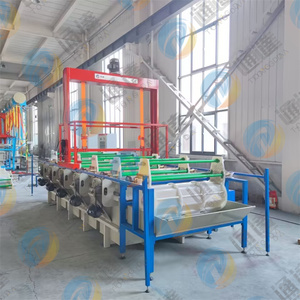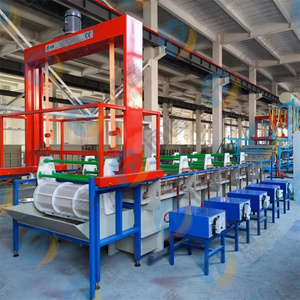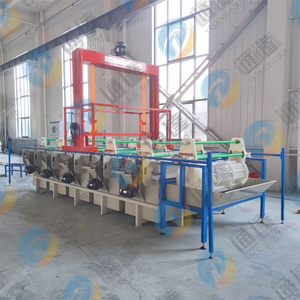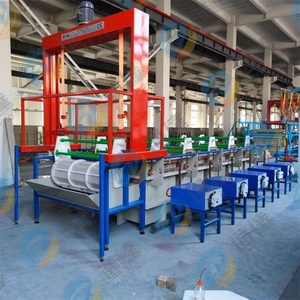
All categories
Featured selections
Trade Assurance
Buyer Central
Help Center
Get the app
Become a supplier

(9980 products available)




















A zinc plating plant is an industrial facility that applies a protective zinc coating to steel or iron products through a process called hot-dip galvanizing or electro-galvanizing. There are two main types of zinc plating plants: hot-dip galvanizing plants and electroplating (electro-galvanizing) plants.
Hot-dip galvanizing plants:
In these plants, the metal parts are first cleaned, then dipped into a molten zinc bath to obtain the coating, and finally cooled and solidified. The entire process can take only a few minutes, resulting in a thicker zinc coating that offers higher corrosion resistance. Hot-dip galvanizing plants are typically part of a large-scale galvanization industry, serving the construction, automotive, infrastructure, and manufacturing sectors. They can handle a high volume of galvanized products and are designed for industrial-level production.
Electroplating (electro-galvanizing) plants:
These plants use an electrochemical process to deposit a thin layer of zinc on the surface of the metal parts. This process involves cleaning the metal surface, applying a chemical solution, immersing the part in an electrolytic cell, and then reversing the process. Electroplating plants are often smaller and may be found as part of a zinc plating facility that includes both electroplating and hot-dip galvanizing. The electro-galvanized coating is typically smoother and more uniform than coatings produced by other methods, making it suitable for automotive and other high-precision applications. Moreover, electro-galvanizing plants use less zinc than hot-dip facilities, making them more environmentally friendly and sometimes preferred for applications where minimal coating thickness is required.
The specifications of a zinc plating plant will vary depending on the capacity, requirements, and structure of the facility. However, here are some general specifications:
It is crucial to maintain a zinc plating plant properly so it can work efficiently for a long time. Regular maintenance checks will help identify any issues or damages early, and these can be fixed right away. Good maintenance practices will also ensure that the quality of zinc plating is consistent and that there are no defects or flaws in the plated products.
The applications of zinc electroplating plants involving various industries, fields, and scenarios.
General Hardware
Fasteners, castings, hinges, and handles are not only functional pieces but also need to resist corrosion. With the help of zinc plating, general hardware can remain functional and intact over time.
Automotive Industry
The components such as lug nuts, door handles, brackets, and chassis parts are prone to wear due to frequent driving. Besides, they are exposed to elements like water and air. Zinc plating provides a protective layer to prevent corrosion and prolong the lifespan of hardware.
Construction
The construction industry uses many materials, like scaffolding, steel, gates, brackets, etc., which are usually exposed to the outside and easily corroded. Therefore, many construction industry products choose zinc plating to increase their anti-corrosion ability.
Farming and gardening machinery
Farming and gardening machinery, such as mowers and plows, are easily corroded by water during farming. However, they need to be maintained to ensure the quality of agricultural products. Machinery parts are often plated with zinc to increase their lifespan and reduce the cost of replacing machinery.
Electronics housing
The human body is very susceptible to electrostatic impact. Zinc plating plants can easily create a Faraday cage around the electrical components to keep people safe, and the electrodes don't need to be expensive. However, zinc plating must be thick enough to withstand 30 years of service in an electrical field.
Pipelines
Zinc plating plants provide various methods to coat the insides of pipelines to prevent corrosion. These techniques include using rotating pipelines, which use centrifugal force to move zinc around the interior of the pipes. Alternatively, immersion methods can also be used.
Business buyers can consider the following factors when selecting the zinc plating plant for sale.
Demand analysis
They need to evaluate the market plating demand. Buyers should determine the sizes, volumes, and types of zinc coatings they will apply. Also, they should consider the source of the metals to be plated. If they will plate large-scale, diverse, industrial, and custom parts, it'll be better to select an efficient, high-capacity, plant with advanced automation.
Quality requirements
Consider the quality of the plating coating. It includes factors like adhesion, corrosion resistance, appearance, and durability. An advanced plant with superior control systems and monitoring functions will achieve those high-quality coatings.
Future growth
The growth zinc plating plants buyers need to consider the expected future demand growth. Will they need to expand capacity later? If so, they need to look for a plating plant that will be easy to upgrade.
Cost
Capital and operating costs are important factors to consider. Apart from the initial purchase cost, buyers also need to estimate the energy and chemical costs, maintenance expenses, and labor needed.
Environmental impact
Buyers should choose a zinc plating plant with an effective emission control system to minimize environmental impacts.
Q1: What are the recent trends in zinc plating plants?
A1: The industry is seeing more eco-friendly practices, like using less energy and recycling water. New tech is making the process faster and smarter, with machines that can adjust themselves. Quality control is better, with more automated checks to ensure the plating is precise. There’s also a rising demand for plating services in electronics and automotive, pushing plants to improve their efficiency.
Q2: Can a zinc plating plant be mobile?
A2: Yes, mobile zinc plating plants are possible. They would include zinc plating tanks, a power supply unit for electrolysis, cleaning and pre-treatment equipment, water recycling systems, and safety features like fume hoods and waste disposal containers. Everything would need to be securely fastened for transport, and the plant would have to comply with local regulations at each deployment site.
Q3: What are the alternatives to zinc plating?
A3: Alternatives include galvanizing, which uses a thicker layer of zinc, thermal spraying of zinc for similar corrosion resistance, zinc-rich paint coatings, or other metal coatings like nickel, chrome, or polymer coatings for specific applications.
Q4: What are the limitations of zinc plating?
A4: Zinc plating may not be the best choice for all situations. It offers moderate abrasion resistance but is not suitable for parts that will face heavy wear. If impact resistance is vital, consider using zinc plating with additional surface coatings. The durability of the plating can depend greatly on the quality of the zinc bath used in the plating plant.